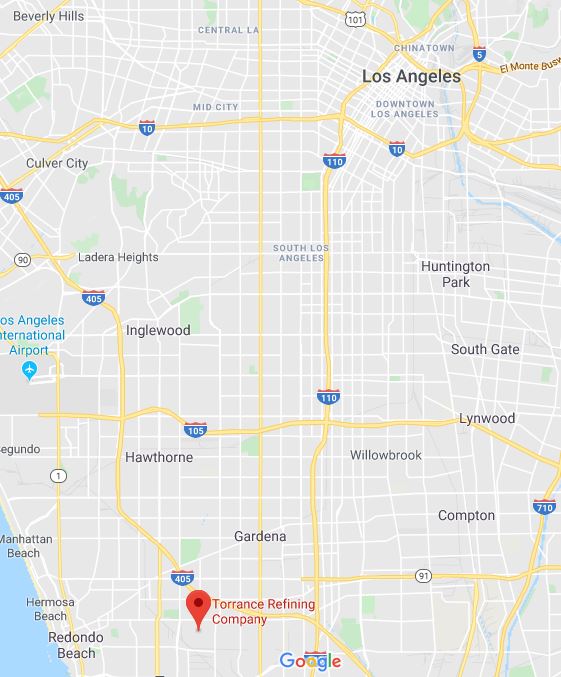Forty-Seven U.S. Refineries, Many in Urban Areas, Use Deadly Hydrofluoric Acid. An Accidental Release Could Kill Thousands.
Tens of thousands of people in our nation could die in a Bhopal-like catastrophe far worse than the 9/11 death toll of nearly 3,000 Americans. The reason is hydrofluoric acid, a chemical so dangerous that it can seep through skin and dissolve bones. Oil refineries use the acid to make gasoline.
The Trump EPA refused to use its authority under the Toxic Substances Control Act to ban oil refineries from using this chemical. Forty-seven of our nation’s approximately 135 oil refineries use hydrofluoric acid, including refineries near Chicago, Los Angeles, New Orleans and Memphis.
“An HF release in an urban area, such as Torrance near downtown LA, could become a mass-casualty event, with the potential for tens of thousands of deaths,” said Jeff Ruch, the Pacific director of Public Employees for Environmental Responsibility.
Alexandra Dapolito Dunn, the EPA assistant administrator for chemical safety, said the petition from PEER didn’t have enough facts to show the rule was necessary.
ACTION BOX/What You Can Do About It
Tell David Fischer at the EPA your thought on oil refineries using hydrofluoric acid. Call him at 202-564-2665 or mail him at EPA Headquarters, William Jefferson Clinton Building, 1200 Pennsylvania Ave., N.W., Mail Code 7101M, Washington, D.C. 20460.
PEER can be reached at 202-265-7337 or [email protected]
“EPA appears to be saying that it will not act until there is a body count,” said former EPA enforcement attorney Tim Whitehouse, now the executive director of PEER.
Hydrofluoric acid has been used in oil refining since the 1940s. The acid boils at 67 degrees, producing a toxic vapor that stays low and can kill up to five miles away from where it’s released.
In June, 5,239 pounds of hydrofluoric acid was released in a series of explosions and a fire that burned for more than 24 hours at a refinery owned by Philadelphia Energy Solutions, the largest refinery on the East Coast.
The ExxonMobile Torrance Refinery is 14 miles from Downtown Los Angeles (Google maps)
The force of the explosion sent the acid high enough in the air that there were no serious injuries or fatalities. About 1,968 pounds of the released acid was contained by a water spray, and the refinery used a safety system that drained a tank of hydrofluoric acid.
In October 1987, more than 1,000 people were treated for injuries after a Marathon refinery in Texas City, Texas, released a cloud of hydrofluoric acid.
The oil industry whose lobbyists include Jeff Miller, once the vice finance chair of Trump’s inauguration committee, would rather risk mass casualties than cut profits. Husky Energy plans to spend more than $400 million to rebuild its refinery in Superior, Wis., after an explosion and fire in April 2018 injured 36 people. It will continue to use hydrofluoric acid. Wisconsin state regulators approved those plans.
The American Chemistry Council, the corporate apologist for hydrofluoric acid, once employed David Fischer, now the deputy assistant administrator in the Trump EPA chemical safety office, and his predecessor, Nancy Beck.
PEER, which asked the EPA to ban hydrofluoric acid under the Toxic Substances Control Act, wanted the agency to use the Clean Air Act to ban the chemical.
The Chemical Safety Board, an independent federal agency, asked the EPA to update its 1993 study of hydrofluoric acid to determine whether refinery plans are adequate to prevent catastrophic releases and whether there are commercially viable, safer alternatives.
Refineries have added chemicals to hydrofluoric acid such as sulfolane to try to limit its danger, but it’s unclear how effective these are. Alternatives do exist such as sulfuric acid which burns but doesn’t form killer vapor clouds.
Chevron is converting its refinery in Salt Lake City to a method called ionic liquids alkylation technology, the first such unit in our country. It is scheduled to start in 2020. The technology has been used in China.
Featured image: A massive explosion and fire wrecked the Philadelphia Energy Solutions refinery in June. (WPVI-TV)





